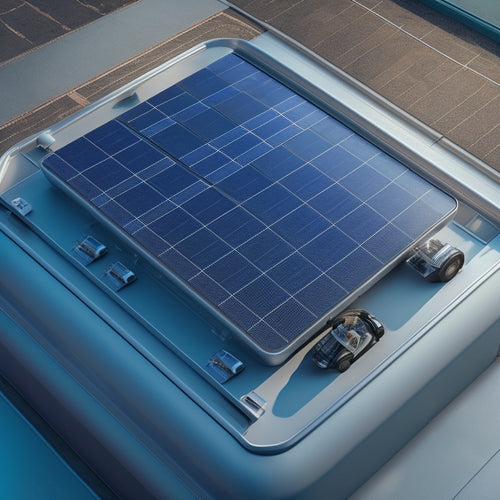
Key Elements of a Residential Solar Inverter Installation
Share
When installing a residential solar inverter, you need to guarantee that five critical elements are carefully addressed to secure a safe, efficient, and productive system. You'll need to select the right inverter size and type, considering factors like panel wattage and voltage output, and mount it securely using specialized brackets and hardware. Proper electrical connections, wiring, and grounding are also crucial, as is regular monitoring and maintenance to prevent issues and optimize energy production. Finally, you must incorporate essential safety features, such as surge protection and ground fault detection, to guarantee compliance with national safety standards. Confirm you get it right, as the entire system's performance depends on it.
Key Takeaways
- Correct inverter sizing and selection ensure maximum energy production, considering factors like panel number, wattage, voltage, and current output.
- Proper mounting and grounding methods, adhering to manufacturer's instructions and NEC guidelines, ensure safe and secure installation.
- Electrical connections and wiring must meet required ampacity and outdoor ratings, with secure routing, proper labeling, and documentation.
- Regular monitoring and maintenance, including inspections and software updates, are crucial to optimize energy production and prolong system lifespan.
- Safety features, such as surge protection, ground fault protection, and compliance with UL and IEEE certifications, prevent electrical shocks and fires.
Inverter Sizing and Selection
Optimization is key when it comes to utilizing the power of residential solar energy, and it all starts with selecting the right inverter. You need to verify that your inverter is compatible with your solar panel array, as a mismatch can lead to reduced energy production and compromised inverter efficiency.
When sizing your inverter, you'll want to take into account factors such as the number of solar panels, their wattage, and the voltage and current output. A correctly sized inverter will maximize energy production and minimize energy losses.
Inverter compatibility is also essential, as different inverters have varying voltage and current input ranges. You'll want to choose an inverter that can handle the maximum power output of your solar panel array, as well as any potential voltage fluctuations.
Additionally, look for an inverter with high efficiency ratings, as this will minimize energy losses and maximize your energy production. By selecting the right inverter, you'll be able to maximize the power output of your residential solar energy system and enjoy the benefits of clean, renewable energy.
Mounting and Grounding Methods
Your residential solar inverter's performance relies heavily on its mounting and grounding methods, which can greatly impact its efficiency, reliability, and safety.
When it comes to mounting techniques, you'll need to confirm your inverter is securely fastened to a suitable surface, such as a wall or roof. This typically involves using specialized brackets and hardware designed for the specific inverter model and installation environment.
It's vital to follow the manufacturer's instructions and take into account factors like wind loading, seismic activity, and environmental conditions.
Grounding systems are equally important, as they protect your inverter and entire solar array from electrical shock and damage.
You'll need to install a grounding electrode, such as a copper rod or plate, that connects to your inverter's grounding terminal.
The National Electric Code (NEC) provides guidelines for grounding systems, including requirements for bonding and earthing.
Electrical Connections and Wiring
Once you've secured your residential solar inverter using approved mounting and grounding methods, it's time to focus on making the electrical connections and wiring. This critical step requires attention to detail and adherence to wiring standards to guarantee a safe and efficient system.
When making electrical connections, you'll need to take into account the following key factors:
-
Connection types: Ascertain you're using the correct connection types for your inverter and electrical system, such as MC4 connectors or terminal blocks.
-
Wiring size and material: Select wiring that meets the required ampacity and is rated for outdoor use, such as copper or aluminum wire.
-
Wire routing and management: Route wires neatly and securely to prevent damage and guarantee easy maintenance access.
- Labeling and documentation: Properly label and document all connections and wiring to facilitate future maintenance and troubleshooting.
Monitoring and Maintenance Needs
Regularly, your solar inverter system requires monitoring and maintenance to guarantee peak performance, prevent potential issues, and prolong its lifespan. This involves performance tracking, which enables you to identify areas of improvement and optimize energy production. You'll want to perform routine inspections to detect any potential issues before they become major problems.
| Maintenance Tasks | Frequency |
|---|---|
| Visual inspection of the system | Quarterly |
| Performance tracking and analysis | Monthly |
| Inverter software updates | Semiannually |
| Cleaning of panels and inverters | Annually |
| Thorough system inspection | Biannually |
Safety Features and Certifications
A residential solar inverter installation is only as reliable as its safety features and certifications. You want to guarantee that your system is protected from potential hazards and meets the required standards.
Safety features are vital to preventing electrical shocks, fires, and other accidents.
When it comes to safety features, look for the following:
-
Surge protection: Your inverter should be equipped with surge protection devices to absorb voltage spikes and protect your system from power surges.
-
Grid compatibility: Your inverter must be compatible with the grid's voltage and frequency to guarantee safe and efficient energy transfer.
-
Ground fault protection: This feature detects and interrupts ground faults to prevent electrical shocks and fires.
- Certifications and compliance: Verify your inverter meets local and international safety standards, such as UL (Underwriters Laboratories) and IEEE (Institute of Electrical and Electronics Engineers) certifications.
Frequently Asked Questions
Can I Install a Residential Solar Inverter in a Detached Garage?
You can install a residential solar inverter in a detached garage, considering factors like ventilation, temperature, and electrical connections. This setup offers benefits like increased energy independence and reduced clutter in your main living space.
How Often Should I Clean My Solar Panels to Maintain Efficiency?
Just like a gardener tends to their garden, you should regularly tend to your solar panels to guarantee peak performance. For peak efficiency, clean your panels every 6-12 months as part of your regular panel maintenance, adjusting the cleaning frequency based on your environment.
Are Residential Solar Inverters Compatible With Generators?
You'll be glad to know that many residential solar inverters are compatible with generators, especially grid-tie inverters with backup capabilities, but it's essential to check the inverter type and manufacturer specifications to guarantee seamless generator compatibility.
Can I Use a Residential Solar Inverter for Commercial Purposes?
You're likely aware that over 1 million solar inverters are installed globally each year. However, you can't simply use a residential solar inverter for commercial purposes, as commercial energy needs often exceed residential solar inverter specifications, requiring more resilient systems.
Do Residential Solar Inverters Work With Dc-Powered Appliances?
You'll be pleased to know that residential solar inverters can work with DC-powered appliances, but it's essential to verify the inverter's DC appliance compatibility and ideal inverter efficiency to maximize your system's overall performance and energy harvesting capabilities.
Conclusion
As you maneuver through the intricate terrain of residential solar inverter installation, remember that each component is like a puzzle piece that must fit together seamlessly. With inverter sizing and selection, mounting and grounding methods, electrical connections and wiring, monitoring and maintenance needs, and safety features and certifications all in place, your system will hum like a well-oiled machine, efficiently utilizing the sun's energy and powering your home.
Related Posts
-

Top Solar Panels for Car Battery Maintenance
When selecting top solar panels for car battery maintenance, consider high-efficiency models with high wattage output...
-

10 Best Solar Panel Options for Motorhomes Online
When choosing the best solar panel for your motorhome, consider factors like efficiency, durability, and design. You'...
-

Planning for an Electric Vehicle-Friendly Urban Future
As you plan for an electric vehicle-friendly urban future, you'll need to integrate high-power charging stations, sma...


